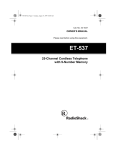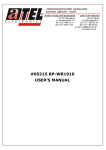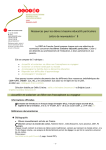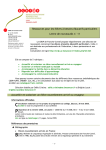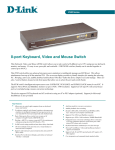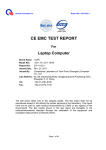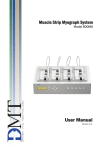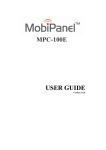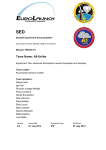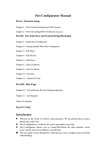Download User`s Manual
Transcript
User’s Manual Version 1.0 March 2015 EZswitch-0B-v1.0-E Disclaimer Information in this document is subject to change without notice. The manufacturer does not make any representations or warranties (implied or otherwise) regarding the accuracy and completeness of this document and shall in no event be liable for any loss of profit or any other commercial damage, including but not limited to special, incidental, consequential, or other damages. No part of this document may be reproduced or transmitted in any form by any means, electronic or mechanical, including photocopying, recording or information recording and retrieval systems without the express written permission of the manufacturer. All brand names and product names used in this document are trademarks, or registered trademarks of their respective holders. FCC Statement This device generates and uses radio frequency and may cause interference to radio and television reception if not installed and used properly. This has been tested and found to comply with the limits of a Class B computing device in accordance with the specifications in Part 15 of the FCC Rules. These specifications are designed to provide reasonable protection against such interference in a residential installation. However, there is no guarantee that interference will not occur in a particular installation. If this device does cause harmful interference to radio or television reception, which can be determined by plugging the device in and out, the user can try to correct the interference by one or more of the following measures: Reorient or relocate the receiving antenna. Increase the separation between the device and receiver. Connect the computer into an outlet on a circuit different from that to which the receiver is connected. Consult the dealer or an experienced radio/TV technician for help. Rack-mount Safety Instructions Elevated Operating Ambient – If installed in a closed or multi-unit rack assembly, the operating ambient temperature of the rack environment may be greater than room ambient. Therefore, consideration should be given to installing the equipment in an environment compatible with the maximum ambient temperature (Tma) specified by the manufacturer. Reduced Air Flow – Installation of the equipment in a rack should be such that the amount of air flow required for safe operation of the equipment is not compromised. Mechanical Loading – Mounting of the equipment in the rack should be such that a hazardous condition is not achieved due to uneven mechanical loading. Circuit Overloading – Consideration should be given to the connection of the equipment to the supply circuit and the effect that overloading of the circuits might have on overcurrent protection and supply wiring. Appropriate consideration of equipment nameplate ratings should be used when addressing this concern. Reliable Earthing – Reliable earthing of rack-mounted equipment should be maintained. Particular attention should be given to supply connections other than direct connections to the branch circuit (e.g. use of power strips). Contents 1. INTRODUCTION ........................................................................................................................................1 2. SPECIFICATION ........................................................................................................................................2 3. SYSTEM REQUIREMENTS .....................................................................................................................3 4. INSTALLATION ..........................................................................................................................................3 4.1. FRONT VIEW ........................................................................................................................................3 4.2. REAR VIEW ..........................................................................................................................................4 4.3. INSTALL A KVM SWITCH (SINGLE-TIER INSTALLATION) ....................................................................4 4.3.1. Installation Guidelines .........................................................................................................4 4.3.2. Console Connection .............................................................................................................4 4.3.3. System Connection ..............................................................................................................5 4.4. CASCADE KVM SWITCHES (MULTI-TIER INSTALLATION) ..................................................................7 4.5. FIRMWARE UPGRADE PORT ................................................................................................................9 4.6. RACK-MOUNT THE KVM SWITCH .......................................................................................................9 5. OPERATION ...............................................................................................................................................9 6. HOT KEY OPERATION...........................................................................................................................10 6.1. TRIGGER THE OSD MENU ................................................................................................................10 6.2. SET THE LEADING HOT KEY .............................................................................................................10 6.3. CHANNEL SELECTION IN A SINGLE-TIER KVM SYSTEM ..................................................................10 6.3.1. Select a Specific Channel .................................................................................................10 6.3.2. Channel Switching Using Arrow Keys ........................................................................... 11 6.3.3. Channel Switching Using the <ALT> Key ..................................................................... 11 6.4. CHANNEL SELECTION IN A MULTI-TIER KVM SYSTEM ....................................................................12 6.5. DISABLE OR ENABLE THE BUZZER ...................................................................................................13 6.6. AUTO-SCAN FUNCTION .....................................................................................................................13 6.6.1. Enable the Auto-Scan Function .......................................................................................13 6.6.2. Disable the Auto-Scan Function......................................................................................14 6.6.3. Different Auto-Scan Modes ...............................................................................................14 6.6.4. Auto-Scan Time Interval ....................................................................................................14 6.7. 7. CONSOLE LOCK ................................................................................................................................15 OSD OPERATION ...................................................................................................................................15 7.1. OSD MAIN MENU ..............................................................................................................................15 7.1.1. Tier Number ..........................................................................................................................15 7.1.2. Channel Name ......................................................................................................................15 7.1.3. Computer & KVM Switch Status ......................................................................................16 i 7.1.4. Currently Selected Channel Number..............................................................................16 7.1.5. Parent Channel Number ....................................................................................................17 7.1.6. Page Down / Up Indicator..................................................................................................17 7.1.7. Function Keys Menu...........................................................................................................17 7.2. CHANNEL SELECTION USING THE OSD ...........................................................................................17 7.2.1. Select a Channel ..................................................................................................................17 7.2.2. Select a Second- or Third-Tier Channel ........................................................................18 7.2.3. Return to the Upper-Tier OSD ..........................................................................................18 7.3. SETUP MENU .....................................................................................................................................18 7.3.1. Scan Mode ............................................................................................................................19 7.3.2. Scan Time ..............................................................................................................................19 7.3.3. Banner Time .........................................................................................................................19 7.3.4. Position ..................................................................................................................................19 7.3.5. Hot Key ..................................................................................................................................20 7.3.6. Sound .....................................................................................................................................20 7.3.7. Language ...............................................................................................................................20 7.4. AUTO-SCAN USING THE OSD ..........................................................................................................21 7.4.1. Enable the Auto-Scan Function .......................................................................................21 7.4.2. Disable the Auto-Scan Function......................................................................................21 7.4.3. Different Auto-Scan Modes ...............................................................................................22 7.4.4. Auto-Scan Time Interval ....................................................................................................22 7.5. CONSOLE LOCK USING THE OSD ....................................................................................................22 7.6. RENAME A CHANNEL .........................................................................................................................23 7.7. SECURITY SETUP ..............................................................................................................................23 7.7.1. Security Mode Login ..........................................................................................................23 7.7.2. Security Mode ......................................................................................................................24 7.7.3. Change the Administrator Password .............................................................................24 7.7.4. User Account Settings .......................................................................................................25 7.7.5. User Authorization Settings .............................................................................................25 7.8. PORT LOCK .......................................................................................................................................26 7.8.1. Lock a Channel Port ...........................................................................................................26 7.8.2. Select a Locked Channel ...................................................................................................27 7.8.3. Unlock a Channel Port .......................................................................................................27 7.9. EXIT OSD ..........................................................................................................................................27 8. SPECIAL SUN KEY EMULATION ........................................................................................................28 9. TROUBLESHOOTING ............................................................................................................................29 10. FIRMWARE UPGRADE ..........................................................................................................................30 ii 11. TIERING WITH DOMINION KX II ..........................................................................................................35 11.1. CONNECT EZSWITCH TO DOMINION KX II ........................................................................................35 11.2. CONFIGURE DOMINION KX II ............................................................................................................35 11.3. REMOTE ACCESS TO AN EZSWITCH CHANNEL ................................................................................37 12. KEYBOARD AND MOUSE COMPATIBILITY .....................................................................................38 12.1. MOUSE COMPATIBILITY TABLE.........................................................................................................38 12.2. KEYBOARD COMPATIBILITY TABLE ..................................................................................................43 iii iv 1. Introduction Thank you for purchasing EZswitch, an 8-port or 16-port keyboard/video/mouse (KVM) switch. The product enables you to control 8 or 16 computers or servers from one console with PS/2 or USB input devices and a regular monitor. Features Supports the PS/2 and USB keyboard and mouse Computer connection via PS/2 or USB interface Fully compliant with the USB 1.1/ 2.0 specification Multi-platform support, including Windows, Linux, Mac OS9/OSX, and Sun Microsystems Supports VGA resolutions up to 2048 x 1536 Intuitive On-Screen-Display (OSD) interface for simple operation Supports chain cascading function on the OSD Expands to 4,096 computers via a 3-tier daisy chaining configuration (using 16-port KVM switches) No special configuration required for cascading KVM switches Supports tiering with Raritan’s Dominion® KX II models (see the section “11. Tiering with Dominion KX II”) Emulates a PS/2 or USB keyboard on each connected computer for normal boot without any keyboard error Hot swappable components with no impact on the operation Quick channel switching through: - Push buttons on the KVM switch - Hot keys using the keyboard - OSD interface Auto-scan function for automatically cycling through all channels An LED display for computer status monitoring Provides a beeper for indication of channel switching Rack-mountable in a 19” system rack (1U) Firmware upgradeable Package Contents The product package includes the following items: One 8-port or 16-port EZswitch One user’s manual (with warranty card included) One power adaptor One rackmount bracket kit Custom KVM cables 1 2. Specification Specification Maximum number of computers 8 or 16 Channel selection Push buttons, hot key or OSD interface LEDs Red ones for indicating the computer selection Green ones for indicating the computer accessibility Channel ports: Console ports: Video 8 or 16 HDB-15 female connectors (KB/MS) (PS/2 & USB signals combined) PS/2 keyboard One 6-pin mini-DIN female connector PS/2 mouse One 6-pin mini-DIN female connector Video One HDB-15 female connector USB keyboard One USB A type female connector USB mouse One USB A type female connector Auto-Scan interval Adjustable via the OSD DDC, DDC2 monitor resolution Up to 2048 x1536@65Hz Hot swappable Yes Operating systems Windows 98SE/Me/2000/XP/2003/Vista/7, Linux, Mac OS9/OSX and Sun Microsystems Power supply External power adaptor Dimensions (L x W x H) 44 x 15.7 x 4.5 cm (17.3 x 6.1 x 1.5 inch) Weight 1750g / 1900g Housing material Metal Operating temperature 32~122°F (0~50°C) Humidity 0%~80%RH Firmware upgrade port Mini USB female 2 3. System Requirements Console Requirements: A VGA, SVGA or Multisync monitor with high resolution capability PS/2 or USB keyboard and mouse Computer (Server) Requirements: Equipped with a VGA, SVGA or Multisync video card Equipped with USB A type ports or PS/2 6-pin mini-DIN connectors for keyboard and mouse Cable Requirements: Custom KVM cables Note: To purchase these cables, contact your dealer or Raritan. 4. Installation 4.1. Front View Figure 1: Front view of the 8-port switch Figure 2: Front view of the 16-port switch LED Indicators: “Selected” LEDs: A lit RED LED indicates that the computer connected to the corresponding channel is selected. “On-Line” LEDs: A lit GREEN LED indicates that a computer is physically connected to the corresponding channel and is ready to access. 3 Reset Switch: Press the Reset switch when you want to reset the system. This switch must be pressed with a pointed object, such as a paper clip or a ball-point pen. 4.2. Rear View Figure 3: Rear view of the 8-port switch Figure 4: Rear view of the 16-port switch 4.3. Install a KVM Switch (Single-Tier Installation) 4.3.1. Installation Guidelines All computers and devices must be turned OFF prior to installation. Disconnect power cords from the computers implemented with the Keyboard Power On function prior to installation, or the KVM switch may not work properly. Computers running Windows 98 must be connected to a KVM switch via PS/2 ports because Windows 98 does not support initial installation through the USB HID driver. Old computers may require USB setting adjustment in the BIOS to enable the USB interface. There is no guarantee that the EZswitch KVM switch can fully support a USB keyboard via a USB hub. 4.3.2. Console Connection Connect a keyboard, mouse and monitor to the console ports on the real panel of EZswitch (see Figure 5). 4 Figure 5: Console connection 4.3.3. System Connection You need a custom combo cable to connect a computer to the EZswitch KVM switch. Note: If needed, contact your dealer or Raritan to purchase the custom KVM cables. Figure 6: Custom KVM cable 5 There are three different ways to connect a computer. See the instructions below: A. Plug the combo cable’s USB, PS/2 keyboard, PS/2 mouse and VGA connectors into a computer (see Figure 7). This method is highly recommended for computer connection. Figure 7: USB, PS/2 and VGA connections B. Plug only the combo cable’s PS/2 keyboard, PS/2 mouse and VGA connectors into a computer (see Figure 8). Figure 8: PS/2 and VGA connections 6 C. Plug only the combo cable’s USB and VGA connectors into a computer (see Figure 9). Figure 9: USB and VGA connections 4.4. Cascade KVM Switches (Multi-Tier Installation) You can cascade either the 8-port or the 16-port EZswitch products up to 3 tiers, expanding the number of computers to 64, 256 or 4096 computers. No special configuration is required for the cascade. After completing the installation, the system automatically configures the Master and Slave KVM switches. The Master KVM switch is the first-tier KVM switch and Slave KVM switches are second-tier or third-tier KVM switches. You can select the computers connected to the Master or Slave KVM switches at any time. To cascade KVM switches, follow these instructions: A. B. Turn OFF all computers and devices. Connect one or more Slave KVM switches to the channel ports on the Master KVM switch using the custom combo cables (see Figure 6). The connection between KVM switches must be done via the PS/2 interface (see Figure 7 & Figure 8 ). C. Connect a USB or PS/2 keyboard and mouse to the console ports on the Master KVM switch. D. Connect a power adaptor to the Master KVM switch. E. Connect computers to available channel ports on the Master KVM switch. F. Connect a power adaptor to each Slave KVM switch. G. Connect computers to available channel ports on the Slave KVM switch. H. Turn on each device in the folloiwng sequence: 1. Master KVM switch 7 I. J. 2. Second-tier Slave KVM switches (connected to the Master KVM switch), if any 3. Third-tier Slave KVM switches (connected to the second-tier Slave KVM switches), if any 4. All computers connected to KVM switches Connect other devices such as a montior or new computers to the Master KVM switch before turning on the additional devices. Now you can hot swap or hot plug any devices into any KVM switches. Both of 8-port and 16-port KVM switches support hot plug and hot swap functions. Figure 10: Cascaded configuration 8 4.5. Firmware Upgrade Port The min-USB female connector on the rear of the EZswitch KVM switch is used for firmware upgrade. Contact your dealer or Raritan when you need to update the firmware. 4.6. Rack-Mount the KVM Switch Figure 11: Rack mounting This section describes how to attach mounting brackets to the KVM switch for rack-mounting it on a standard 19-inch rack. A. Screw the mounting brackets to the sides of the KVM switch (see Figure 11). B. Mount the KVM switch on a rack. 5. Operation You can control computers connected to the EZswitch KVM switch by using the push buttons, hot keys or OSD interface. Push button operation: Press a front panel push button to select the corresponding computer and operate it. Hot Key operation: See the section “6. Hot Key Operation.” OSD operation: See the section “7. OSD Operation.” 9 6. Hot Key Operation 6.1. Trigger the OSD Menu Press <Scroll Lock> twice and then press <Enter>. The OSD main menu will be displayed on the screen. All of the KVM settings can be configured through the OSD interface. Some KVM functions can also be performed using the OSD. <Scroll Lock> + <Scroll Lock> + <Enter> 6.2. Set the Leading Hot Key A hot key allows you to quickly perform a specific function. Its leading key is set to <Scroll Lock> by default. You can change this key if needed. To change the leading hot key, follow this procedure: Press <CTRL> twice, then the new leading hot key, and finally press <Enter>. The leading hot key is changed then. Available leading hot key options include <Scroll Lock>, <Num Lock> and <Caps Lock>. Examples: To set the leading hot key to <Scroll Lock>: <CTRL> + <CTRL> + <Scroll Lock > + <Enter> To set the leading hot key to <Num Lock>: <CTRL> + <CTRL> + <Num Lock> + <Enter> To set the leading hot key to <Caps Lock>: <CTRL> + <CTRL> + <Caps Lock> + <Enter> Tip: You can also change the leading hot key by pressing <F1> in the OSD main menu. See the section “7.3.5 Hot Key.” 6.3. Channel Selection in a Single-Tier KVM System 6.3.1. Select a Specific Channel You can select a connected computer by using the hot key combination: first press <Scroll Lock> twice, then a number (1~16) corresponding to the channel number of the computer that you want to control, and finally press <Enter>. 10 Figure 12: Channel selection hot key … Examples: <Scroll Lock> + <Scroll Lock> + <1> + <Enter> <Scroll Lock> + <Scroll Lock> + <2> + <Enter> <Scroll Lock> + <Scroll Lock> + <16> + <Enter> Tip: You can also select a computer in the OSD menu. See the section “7.2 Channel Selection Using the OSD.” 6.3.2. Channel Switching Using Arrow Keys To switch to the prior or next channel that is adjacent to the current channel, do this: first press <Scroll Lock> twice, and then the <Left arrow> or <Right arrow> key. To switch to the prior channel: <Scroll Lock> + <Scroll Lock> + <Left arrow> To switch to the next channel: <Scroll Lock> + <Scroll Lock> + <Right arrow> 6.3.3. Channel Switching Using the <ALT> Key You can also switch to the prior or next channel using the <ALT> key combinations. A. Enable the <ALT> channel switching function: By default, the channel switching function using the <ALT> key is disabled. To enable it, press <Scroll Lock> twice, then <ALT> and finally <Enter>. To disable the function, press the same key combinations again. 11 B. Switch to the prior or next channel using the <ALT> key: Press the <Left ALT> or <Right ALT> key twice, and the system will automatically switch to the prior or next channel. Enable/disable the <ALT> channel switching function: <Scroll Lock> + <Scroll Lock> + <ALT> + <Enter> Switch to the prior channel: <Left ALT> + <Left ALT> Switch to the next channel: <Right ALT> + <Right ALT> 6.4. Channel Selection in a Multi-Tier KVM System A cascaded KVM system allows you to select a channel at any tier directly. Use the following hot key combination to select a channel: Press <Scroll Lock> twice, the <D> key, then the number of the channel (1~16) where the computer or the second or third tier is connected, and finally press <Enter>. Select a channel at the first tier: <Scroll Lock> + <Scroll Lock> + <D> + <1st tier channel number> + <Enter> Select a channel at the second tier: <Scroll Lock> + <Scroll Lock> + <D> + <1st tier channel number> + <D> + <2nd tier channel number> + <Enter> Select a channel at the third tier: <Scroll Lock> + <Scroll Lock> + <D> + <1st tier channel number> + <D> + <2nd tier channel number> + <D> + <3rd tier channel number> + <Enter> For example, to select channel 7 at the last tier in a 3-tier configuration, you may press <Scroll Lock> twice, then D2D5D7, and finally <Enter>. D2 means channel 2 of the first tier. D5 means channel 5 of the second tier. D7 means channel 7 of the third tier. 12 Tip: You can also select a channel of a multi-tier KVM system using the OSD menu. See the section “7.2.2 Select a Second- or Third-Tier Channel.” 6.5. Disable or Enable the Buzzer To disable or enable the buzzer function, press <Scroll Lock> twice, then <B> and <Enter>. The buzzer is enabled by default. <Scroll Lock> + <Scroll Lock> + <B> + <Enter> Tip: You can also enable/disable the buzzer by pressing <F1> in the OSD main menu. See the section “7.3.6 Sound.” . Figure 13: Hot key for buzzer 6.6. Auto-Scan Function After enabling the Auto-Scan function, the KVM switch will cycle through all channels and display them one by one on the screen. At this time, both of the mouse and keyboard are disabled to prevent any accidental operation errors, such as erratic movement of the mouse or wrong inputs. 6.6.1. Enable the Auto-Scan Function To activate the Auto-Scan function, press <Scroll Lock> twice, then <S> and <Enter>. <Scroll Lock> + <Scroll Lock> + <S> + <Enter> A banner will be shown on the screen to indicate the currently-scanned channel. 13 Tip: You can also enable the Auto-Scan function in the OSD main menu. See the section “7.4 Auto-Scan Using the OSD.” Figure 14: Auto-Scan hot key ─┬── ┬ ──┬────── │ │ │ └────────── └─ └─────────────── Channel name Channel number Current mode Figure 15: Auto-Scan banner 6.6.2. Disable the Auto-Scan Function To quit the Auto-Scan mode, press any key on the keyboard. You can also quit the mode by pressing a push button on the KVM front panel to select the corresponding channel. 6.6.3. Different Auto-Scan Modes There are two types of Auto-Scan modes: Scan all computers that are powered on. Scan only those computers which have been marked to be scanned. See the section “7.3.1 Scan Mode” to set the Auto-Scan mode. 6.6.4. Auto-Scan Time Interval The Auto-Scan time interval can be adjusted by pressing <F1> in the OSD main menu. See the section “7.3.2 Scan Time.” 14 6.7. Console Lock If the security mode has been enabled (by pressing <F5> in the OSD mode), you can lock the console by pressing <Scroll Lock> twice, then <H> and <Enter>. The KVM switch will be locked until a user logs in successfully. <Scroll Lock> + <Scroll Lock> + <H> + <Enter> To unlock the console, follow the onscreen messages to press any key, and type the User Name and Password. After the successful login, the KVM switch and console devices are unlocked and you can resume normal operation. Tip: You can also lock the console in the OSD main menu. See the section “7.5 Console Lock Using the OSD.” 7. OSD Operation 7.1. OSD Main Menu To trigger the OSD main menu, press <Scroll Lock> twice and <Enter>. The OSD main menu shows all channel numbers, names and status. See Figure 16. Figure 16: OSD main menu 7.1.1. Tier Number 1st, 2nd or 3rd, which is displayed in the upper-left corner of the OSD main s menu indicates the currents tier. 7.1.2. Channel Name The channel name can be changed by pressing the function key <F4>. You can give the channel a meaningful name for easily identifying the connected 15 computer. A highlight bar in pink shows which channel is being selected. A plus mark (+) to the left of the channel name means the channel port is connected to a second- or third-tier KVM switch. 7.1.3. Computer & KVM Switch Status Buzzer status of the KVM switch : Buzzer is turned on. : Buzzer is tuned off. Logged-in user name The system provides one administrator and 3 user names for security management. The current login name (if available) is displayed next to the buzzer status. Channel lock status (Status STA) L: The presence of the L letter indicates that channel is locked. BLANK: The absence of the L letter indicates that channel is NOT locked. Computer power-on status (Status STA) The OSD menu will update the flag automatically if the computer status is changed. A: The presence of the A letter indicates the connected computer is powered on and can be selected. BLANK: The absence of the A letter indicates a computer is NOT connected or NOT powered on. Channel scan tag (Status STA) S: The presence of the S letter indicates the channel is included as one of the channels to be scanned in the Auto-Scan mode. Note that the channel will be scanned only when the scan mode is set to the Select type. BLANK: The absence of the S letter indicates the channel is NOT marked for Auto-Scan 7.1.4. Currently Selected Channel Number The number shown in the upper-right corner of the OSD main menu indicates the currently selected channel number. If the selected channel is on the 2nd or 3rd tier, the channel number looks like XX-YY-ZZ. For example, 02-05-07 means the selected channel is channel 7 of the third tier, which is connected to the channel 5 of the second tier, which is 16 connected to the channel 2 of the first tier. 7.1.5. Parent Channel Number The number below the tier number is the channel number of the upper tier, where the tiered KVM switch is connected. For example, 8 means channel 8 of the upper-tier KVM switch. This number is available for the 2nd- and 3rd-tier channels, but unavailable for the1st tier. 7.1.6. Page Down / Up Indicator This indicator is available for the16-port KVM switch only. The 16-port KVM switch displays 16 channels in two pages: the first page shows the first eight channels, and the second page shows the last eight channels. Therefore, the Page Down / Up indicator appears to remind users to go to the other page by pressing the <Page Down> and <Page Up> key. 7.1.7. Function Keys Menu The following lists the function keys that can be used for operation: <F1>: Trigger the setup menu <F2>: Enable the Auto-Scan function <F3>: Set up the lock and unlock function (available only when the security function is enabled) <F4>: Rename the selected channel <F5>: Set up the security function and user authorization settings <F6>: Lock the channel (available for the administrator only) More information regarding these function keys is described in later sections. 7.2. Channel Selection Using the OSD 7.2.1. Select a Channel Use the <UP arrow> and <DOWN arrow> keys to highlight a channel and then press <Enter>. A bar showing the channel name appears in the upper-left corner of the screen. 17 ┬ ────┬────── │ └ Channel name └──────────── Channel number Figure 17: Channel banner (single tier) 7.2.2. Select a Second- or Third-Tier Channel A plus mark (+) to the left of the channel name indicates a tiered KVM switch is connected to this channel port. Pressing <Enter> lets you enter the next tier, and the screen displays a list of channels of the selected Slave KVM switch. ┬ ┬ ┬ ────┬────── │ │ │ │ │ └─────── 3rd tier channel number │ └────────── 2nd tier channel number └ Channel name └────────────── 1st tier channel number Figure 18: Channel banner (multi tier) 7.2.3. Return to the Upper-Tier OSD To return to the OSD menu of the upper tier, press <R>. 7.3. Setup Menu In the Setup menu, you can use these keys: To select the field whose settings you want to change, press the <Up arrow> or <Down arrow> key. To change the settings, press the <Left arrow> or <Right arrow> key. To save the changes and exit, press <ESC>. 18 Figure 19: OSD Setup menu 7.3.1. Scan Mode Select: With this option selected, only the channels that are marked with S in the STA column in the OSD main menu will be scanned after entering the Auto-Scan mode. PC ON: This option will scan all channels where computers are connected and powered on. 7.3.2. Scan Time The default scan time interval is 5 seconds. The value is an integer multiple of 5 between 5 and 255. 7.3.3. Banner Time By default, a channel banner is displayed on the screen for 5 seconds. The options include 5, 10 and 15 seconds and All. Selecting “All” causes the banner to be displayed all the time. 7.3.4. Position Menu: Press the arrow keys to move the OSD main menu until it reaches the desired position. Then press <ESC> to save the new position. 19 Figure 20: Menu position setup Banner: Press the arrow keys to move the channel banner until it reaches the desired position. Then press <ESC> to save the new position. Figure 21: Channel banner position setup 7.3.5. Hot Key The default hot key is <Scroll Lock>. You can change the hot key and set it to <Num Lock> or <Caps Lock> if necessary. Tip: To change the leading hot key, you must use the hot key combination: <CTRL> + <CTRL> + <New leading hot key> + <Enter>, when NOT in the OSD mode. See the section “6.2 Set the Leading Hot Key.” 7.3.6. Sound ON: Buzzer is enabled. OFF: Buzzer is disabled. Tip: You can also enable/disable the buzzer by using the hot key combination: <Scroll Lock> + <Scroll Lock> + <B> + <Enter>, when NOT in the OSD mode. See the section “6.5 Disable or Enable the Buzzer.” 7.3.7. Language 3 languages are available for showing the OSD menus, including English (En), Deutsch (De), and Francais (F). 20 7.4. Auto-Scan Using the OSD 7.4.1. Enable the Auto-Scan Function To activate the Auto-Scan function in the OSD mode, press <F2>. The Auto-Scan banner is displayed to indicate the currently-scanned channel. ─┬── ┬ ──┬────── │ │ │ └────────── └─ └─────────────── Channel name Channel number Current mode Figure 22: Auto-Scan banner Tip: You can also activate the Auto-Scan function by using the hot key combination: <Scroll Lock> + <Scroll Lock> + <S> + <Enter>, when NOT in the OSD mode. See the section “6.6.1 Enable the Auto-Scan Function.” 7.4.2. Disable the Auto-Scan Function To quit the Auto-Scan mode, press any key on the keyboard. The Auto-Scan banner disappears when the Auto Scan stops. 21 7.4.3. Different Auto-Scan Modes There are two types of Auto-Scan modes: Scan all computers that are powered on. Scan only those computers which have been marked to be scanned. See the section “7.3.1 Scan Mode” to set the Auto-Scan mode. 7.4.4. Auto-Scan Time Interval The Auto-Scan time interval can be adjusted by pressing <F1> in the OSD main menu. See the section “7.3.2 Scan Time.” 7.5. Console Lock Using the OSD If the security mode has been enabled (see the section “7.7 Security Setup”), you can lock the console by pressing <F3> in the OSD mode to log out of the system. The Console Lock banner is displayed on the screen. Figure 23: Console Lock banner The KVM switch will be locked until a user logs in successfully. User Name: JERRY Password: Figure 24: Login banner Tip: You can also logout to lock console by using the hot key combination: <Scroll Lock> + <Scroll Lock> + <H> + <Enter>, when NOT in the OSD mode. See the section “6.7 Console Lock.” If you forget your password, the only way to disable the security function is to type a universal password to unlock the KVM switch. Contact your dealer or Raritan Technical Support for the universal password. 22 7.6. Rename a Channel Select the channel that you want to rename by pressing the Up/Down arrow keys and then <F4> in the OSD main menu. The Rename dialog appears for you to change the channel name. Press <Enter> to save the new channel name or <ESC> to cancel. Figure 25: Rename dialog 7.7. Security Setup 7.7.1. Security Mode Login Press <F5> in the OSD main menu to enter the security setup mode. The administrator login is required for entering the security mode. User Name: admin Password: Figure 26: Security mode login prompt The default administrator account is: User Name: admin Password: 123456 Press <Enter> after typing the admin user name and password respectively. The security setup menu is shown on the screen after successful login. Press the <Up arrow> and <Down arrow> keys to select the security field, and then press the <Left arrow> and <Right arrow> keys to change the settings. 23 Figure 27: Security setup menu 7.7.2. Security Mode To change the security mode settings, move the highlight bar to the Security Mode field, and press the <Left arrow> or <Right arrow> key to change the option. The following functions cannot be performed without enabling the security mode: Console Lock: <F3> Port Lock: <F6> User authorization settings 7.7.3. Change the Administrator Password To change the administrator password, move the highlight bar to the Admin/Password field, and press the <Left arrow> or <Right arrow> key. The admin password setup dialog is shown on the screen. Type the new password in the New Password field, and then press <Enter> to accept it or <ESC> to quit. Type the same password again in the Confirm Password field, and press <Enter> to accept it or <ESC> to quit. 24 Figure 28: Administrator password setup dialog 7.7.4. User Account Settings 3 built-in user accounts are permitted to access and administer the KVM switch: ABC, DEF, and GHI. To change the user name and set the password, move the highlight bar to one of the user names. Then press the <Left arrow> or <Right arrow> key. The user account setup dialog is shown on the screen. Type the new user name and press <Enter> to accept it or <ESC> to cancel. Type the password for the user account in the New Password field and type the same password again in the Confirm Password field. Figure 29: User account setup dialog 7.7.5. User Authorization Settings You can set up the permissions for each user account. Different users may have different access permissions for each channel. To change the access 25 permissions of a specific user, move the highlight bar to the channel, and press <A>, <1>, <2> or <3> to set the channel access permissions for all or specific user accounts. Note: It is not necessary to set the permissions for the administrator since the administrator has full access permissions. Figure 30: User access permission setup 7.8. Port Lock 7.8.1. Lock a Channel Port Only the administrator can lock a channel port. Move the highlight bar to a channel, and press <F6> to lock it. Then a red L letter is displayed in the STA column to indicate the channel is being locked. Figure 31: Lock port in the OSD main menu 26 7.8.2. Select a Locked Channel If anyone selects the channel that has been locked by pressing either the front panel push button or a hot key combination, the OSD main menu appears.Press <ESC> after the OSD main menu appears, and then type the admin user name and password to unlock the channel port when prompted. 7.8.3. Unlock a Channel Port Only the administrator’s user name and password can unlock a channel port. After entering the admin user name and password, the red L letter shown in the STA column disappears, and you can select the channel. 7.9. Exit OSD Pressing <ESC> lets you exit from the OSD interface and return to the selected channel. A banner with the channel name is shown in the upper-left corner of the screen. 27 8. Special Sun Key Emulation A Sun keyboard has 16 special function keys. EZswitch can emulate these function keys with a PS/2 or USB keyboard. See the table below for how to emulate these Sun keys. To activate the emulation function on a PS/2 and USB keyboard: A. Press and hold down the <Left Windows> key, which is usually located between the <Left CTRL> and <Left ALT> key. B. Press the second key listed in the following table. Do not release the <Left Windows> key while pressing the second key. Sun key Press these keys… Stop <Left Windows> + <Left ALT> Props <Left Windows> + <Left CTRL> Compose <Left Windows> + <Left Shift> Front <Left Windows> + <F1> Open <Left Windows> + <F2> Find <Left Windows> + <F3> Again <Left Windows> + <F4> Undo <Left Windows> + <F5> Copy <Left Windows> + <F6> Paste <Left Windows> + <F7> Cut <Left Windows> + <F8> Help <Left Windows> + <F11> Power <Left Windows> + <F12> Mute <Left Windows> + <1> Volume Down <Left Windows> + <2> Volume UP <Left Windows> + <3> 28 9. Troubleshooting Symptom Keyboard and/or mouse not functional Master/Slave daisy chaining does not work Two OSD images appear in the multi-tier configuration Inappropriate OSD menu position Possible cause Recommended solution Keyboard and/or mouse require a reset Unplug and replug the keyboard and/or mouse. Loose cable connection to the computer Verify the cable is securely connected to the KVM switch and to the computer. The KVM switch requires a reset Power cycle all devices. Inappropriate configuration or incorrect installation procedure Verify the Slave’s console is connected to the Master’s PC port. Remove the power supply to the slave (that is, unplug the power adaptor) before connecting it to the Master. Remove the power supply to the slave (that is, unplug the power adaptor) before connecting it to the Master. Verify the Slave’s console is securely connected to the Master’s PC port. Incorrect installation procedure or loose cable connections The OSD menu’s resolution is fixed and its onscreen dimension varies depending on the computer’s VGA resolution that applies 29 In the OSD main menu, press <F1> to change the menu and/or banner’s position. 10. Firmware Upgrade You can update any of the following on a KVM switch through a firmware upgrade: USB Console: Update the USB keyboard/mouse compatibility. The firmware filename for the USB console is similar to OTG_182S_SCAN_Vx.xx.300. PS/2 Console: Update the PS/2 keyboard/mouse compatibility. The firmware filename for the PS/2 console is similar to CONSOLE_Vx.xx.28. OSD: Update the OSD functions. The firmware filename for updating the OSD is similar to OSD_Vx.xx.56. Follow this procedure to update the firmware: A. B. C. D. Disconnect all cables connected from the KVM switch to computers. Disconnect both of the keyboard and mouse connected to the KVM switch. Disconnect the VGA cable connected from the KVM switch to the monitor. Connect the 5V power adaptor to the KVM switch. Figure 32: 5V power adaptor E. Perform the firmware update utility “ExpreZo KVM Upgrade Utility v.1.0.EXE.” 30 Figure 33: KVM upgrade utility window F. Connect the mini-USB cable from the KVM switch’s firmware update port to the USB port on a computer running the firmware update utility. Figure 34: Mini-USB cable G. The utility automatically detects the KVM switch’s programmer. 31 Figure 35: KVM programmer detected message H. Select the item that you want to update by enabling the corresponding checkbox(es). For example, select the “USB Console” checkbox and click the Browse (…) button to select the firmware file. Figure 36: USB Console checkbox selected I. In the Open dialog, select the appropriate firmware file and click Open. 32 Figure 37: Open dialog J. Click the “Program” button to start the firmware update. Figure 38: Program button K. A status bar is displayed at the bottom of the dialog to indicate the update progress. 33 Figure 39: Update progress bar L. The firmware is updated successfully. Figure 40: The successful update message 34 11. Tiering with Dominion KX II Dominion KX II is an enterprise-class, secure, digital KVM switch that provides access and control of servers from anywhere in the world via a web browser. With Dominion KX II, you can have the EZswitch system remotely accessed over a TCP/IP network through the use of a web browser. 11.1. Connect EZswitch to Dominion KX II A. Connect a Dominion Computer Interface Module (CIM) to the video and PS/2 or USB ports on the rear panel of the EZswitch KVM switch. Note: You can use any Dominion CIM except for DCIM-VUSB. B. Connect one end of a UTP (Cat5/5e/6) cable to the CIM and the other end of the cable to one of available server ports on the Dominion KX II KVM switch. Figure 41: Integration of EZswitch and Dominion KX II EZswitch Dominion CIM UTP (Cat5/5e/6) cable Dominion KX II 11.2. Configure Dominion KX II You must configure Dominion KX II for use of hot key sequences to switch between channels of the EZswitch KVM switch. A. Log in to the Dominion KX II. For instructions, see the Dominion KX II User Guide, which can be downloaded from Raritan’s website (www.raritan.com). B. Choose Device Settings > Port Configuration. The Port Configuration page opens. 35 C. Click the name of the port where the EZswitch KVM switch is connected. The Port page opens. D. Select KVM Switch. Figure 42: KVM Switch radio button selected E. Ensure “Generic Analog KVM Switch” is selected in the KVM Switch Model field. F. In the KVM Switch Hot Key Sequence field, select the hot key applied to the EZswitch KVM switch for channel selection. EZswitch’s default hot key is “ScrolLock + ScrolLock + SlotNumber.” Figure 43: KVM Switch Model and KVM Switch Hot Key Sequence fields G. In the Maximum Number of Target Ports (2-32) field, enter the number of your EZswitch device’s channels. Type 8 for an 8-port EZswitch KVM switch or 16 for a 16-port EZswitch KVM switch. H. In the KVM Switch Name field, enter the name you want to use to refer to this port connection. I. Activate the channel ports (targets) that the KVM switch hot key sequence will be applied to by selecting ‘Active’ for each of the ports. Figure 44: Activation of each port J. Click OK. 36 11.3. Remote Access to an EZswitch Channel After properly configuring Dominion KX II, you can remotely access any computer connected to the EZswitch KVM switch via Dominion KX II. A. Launch the web browser, and type the IP address for Dominion KX II. B. The login page opens. Type a valid user name and password, and click Login. Figure 45: Login page C. The Port Access page opens. If not, click the Port Access tab. D. Click the name of the port where EZswitch is connected. All channels (targets) of the EZswitch KVM switch are displayed. Figure 46: Channel ports of EZswitch E. Click the desired channel. F. Click Connect. A Virtual KVM Client window opens to the selected EZswitch channel. Figure 47: Connection to an EZswitch channel For detailed information on Dominion KX II, see the Dominion KX II User Guide, which can be downloaded from the Firmware and Documentation section of Raritan's website (http://www.raritan.com/support/firmware-and-documentation/). 37 12. Keyboard and Mouse Compatibility A number of USB and PS/2 keyboards and mice are compatible with the EZswitch KVM switch. Note that it is likely that the USB or PS/2 keyboards and mice other than those listed in the tables may be also compatible with the product. 12.1. Mouse Compatibility Table Manufacture Model Type Remark A4-TECH NB-50 USB Wireless A4-TECH SWOP-53 USB A4-TECH SWOP-54 PS/2 A4-TECH BW-35 USB A4-TECH SWW-35 PS/2 A4-TECH WWW-25 PS/2 ACME MS-03 PS/2 AMICE AGM201EP USB AMICE AGM202EP PS/2 AMICE BTM-5632 (BTA-3100) USB ANYTIME CREBEP PS/2 A-PLUS MS-1008 USB artmedia EVT-P01 PS/2 Arvel WSMD-DVM PS/2 Asky M058 USB ATake HZ3003 PS/2 BENQ N300 USB Carrefour MMS-001 USB Chic CHIC-800 PS/2 DELL M056UC USB Detrois CanMouse CM313 USB Detrois CanMouse CM317 USB Detrois CanMouse CM337 USB e-Blue WISH Optical Mouse USB Elecom M-N2UGY USB EMI AM-868U USB Ergotech ET-M6613 PS/2 38 Wireless Manufacture Model Type Ergotech ET-M6673 USB Ergotech ET-M6753 USB Ergotech ET-M6913C(MU6) USB Genius NetMouse PS/2 Genius NetScroll EYE PS/2 Model: GM-03001P Genius MINI TRACKER USB Model: GM-04007A/U Genius EasyMouse PS/2 PS/2 Genius P801 PS/2 Genius K3P400A PS/2 Genius MX-526 USB GOOD VISION H3003 PS/2 HAWK 12-OUM233 PS/2 HP 5188-2466 PS/2 HP M-SBJ96 PS/2 IBM M032BO(A) USB IBM MO09BO USB INTROPIC Multi-Media Optical Mouse USB Model: MS-AM-2612U INTROPIC Optical Wheel Mouse USB Model: MS-005-B I-Rock Optical Mouse USB Model IR-7200 JS PM-020(B07) USB KINYO Z30,Z100 PS/2 KINYO KM-V2 USB KINYO KM-755 USB KINYO KM-726 USB KINYO H-3003 USB KOKUYO EAM-UF1v USB KRONE MD-311/PS2 USB LANCE LANCE 2000 G-Mouse USB 39 Remark Wireless Manufacture Model Type Remark LASER-MOUSE ML101 USB LEMEL Browser Mouse PS/2 LEMEL LW3-P PS/2 LEMEL CHIC 730 PS/2 LEMEL 10WCM-B700 PS/2 Logitech C-UM34 USB Wireless Logitech Cordless Click optical mouse USB Wireless USB Wireless USB Wireless Model: M-RAA88 (C-BL4-MSE) Logitech Cordless Notebook Mouse Model: V200 Logitech Cordless Optical Mouse Model: M-RR95 (C-BG17-DUAL) Logitech Cordless Desktop EX100 USB Wireless Logitech Cordless Optical Mouse USB Wireless Model: CM-RR67A Logitech M-RY81CC (C-BK16A-DUAL) USB Wireless Logitech Cordless Wheel Mouse PS/2 Wireless M-RK45 Logitech Logitech Cordless Freedom Navigator USB Logitech MouseMan Wheel M-BD53 USB Logitech Click Optical Mouse USB Logitech MouseMan Optical dual Sensor USB Logitech Optical Mouse MX300 USB Logitech M-BD-53 PS/2 Logitech T-CL13 PS/2 Logitech M-SBF96 PS/2 Logitech M-S28-6MD PS/2 Logitech M-S34 PS/2 Logitech M-S35 PS/2 Logitech M-S38 PS/2 Logitech M-CAA43 PS/2 Logitech M-S28-6MD PS/2 Logitech M-UV96 USB 40 Manufacture Model Type Remark Logitech M-BJ58 USB Logitech M-BP86 USB Logitech M-BQ85 USB Logitech M-BT96A USB Logitech C-UM34 USB Logitech M-RY81CC (C-BK16A-DUAL) USB Wireless Logitech M-RR67A ( BMS-07 ) USB Wireless Logitech S510 USB Wireless Logitech M-RAK898(C-BO33) USB Wireless Logitech LASER V400 USB Wireless Logitech MX Revolution USB Wireless Logitech MX 1100 USB Wireless Logitech VX Nano USB Wireless Logitech M705 USB Wireless Logitech M-BQ85 USB Logitech QuickSilver Mouse 3KEY PS/2 Macally UMF2 USB Macally UMC3 USB MAXXTRO Optical Wheel Mouse USB Model: MH-004 Microsoft Wireless Optical Mouse X09-58309 Microsoft Microsoft P/N: USB Wireless Wireless Optical Mouse 2.0 Model:1008 USB Wireless IntellMouse Optical 1.1 USB P/N: X08-07940 Microsoft Wheel Mouse PS/2 P/N: X03-53717 Microsoft P/N: X09-13962 USB Microsoft Optical Mouse by Starck USB Model: 75578-492 Microsoft Compact Optical Mouse P/N: X802055-002 41 USB Manufacture Model Type Microsoft Basic Optical Mouse USB Microsoft Wheel Mouse Optical USB Microsoft Optical Mouse Blue USB Microsoft IntelliMouse Optical USB Microsoft Notebook Optical Mouse USB Microsoft Wireless IntelliMouse Explorer 2.0 USB Microsoft TrackBall Explorer 1.0 PS/2 USB USB Microsoft Microsoft IntelliMouse USB Microsoft X03-53717 USB Microsoft 1016(X802055-002) USB Microsoft X08-99489 USB Microsoft X09-13962 USB Microsoft Model-1025 USB Microsoft 1030 USB Microsoft ET537 Wireless Microsoft ET733 Wireless MITAC MS MW3-P PS/2 MITSUBISHI AirMouse PS/2 MSI StartMouse USB NEC MS-DC-7006 PS/2 OPTICAL MX-526 USB Optorite LASER MOUSE USB Remark Model: ML 101 QSKY M058 USB SAMAUNG MUY USB SAMAUNG SPM-7000X USB SAMAUNG SPM-4000 USB SANYO SYMS-1606 USB SANYO SYMS-1602 USB SANYO SYS-EI USB SEGATE BROWS MOUSE PS/2 Sensetive Z-WHEEL USB SHARP SHARP USB Mouse (CE-MS02) USB 42 Wireless Manufacture Model Type SONY VGP-UMS50 USB SUN MICROSYSTEMS Crossbow USB USB SVPA Mouse Clicker M01 PS/2 SYNNEX SCROLLING MOUSE PS/2 Remark P/N: 370-3632-01 Model: 0107 T.C.STAR TCM920 USB T.C.STAR Optical Mouse USB Wireless Model: TCM560N TOP-TINT MP-5020-E2 USB TOSHIBA IPC5017A USB ViewSonic ViewMate Optical Mouse USB Model: VS10212 WINTEK 3D Internet Mouse PS/2 Model: WSS23 WINTEK Optical Wheel Mouse Model: WSS36 USB WINTEK 3D Internet Mouse USB Model: WSS56 WINTEK Optical Wheel Mouse USB Model: WSS60 X-PRO Optical Mouse USB Model: A3004045 12.2. Keyboard Compatibility Table Manufacture Model Type A Tale KN-558 USB A4-TECH KB-70 PS/2 A4-TECH KBS-27PU USB A4-TECH KL-23MU PS/2 ADI 647H-K -BPS/2 PS/2 AMICE KB-0420 PS/2 ASUS K7000 USB 43 Remark Manufacture Model Type Atake KJ-118 PS/2 BEAUTY NBK-2198-PS/2 PS/2 BENQ 6511-VA PS/2 BENQ A800 PS/2 BTC 5123 PS/2 BTC 5140 PS/2 BTC 5301 PS/2 BTC 5197 PS/2 BTC 5123W PS/2 BTC E5XKB5301 PS/2 Certified E5XKBM104M10UC PS/2 Chicony 9850 PS/2 COMPAQ 6133-006 PS/2 COMPAQ KU-9978 USB DELL SK-8110 PS/2 DELL SK-8115 USB DTROIS RUNNER 1000 USB EAGLE TOUCH SKB-2200 USB Elecom TK-LU2BSVB(10Keys) USB Esense 13-EWK240 USB Ergotech ET-K701 PS/2 EzKey EZ-6000-PS/2 PS/2 FREE WILL KD-558 USB FUJIEI SK0054 PS/2 GENIUS KU-0368 USB GENUINE 9001A PS/2 Genuine KKB-2050HS USB GVC 5198-PS/2 PS/2 HAWK 13-HME821 PS/2 HP KU-9970 USB IBM SK-8809 USB IBM 0225 PS/2 IBM KB9930 PS/2 44 Remark Wireless Manufacture Model Type Remark IBM KB9939 PS/2 INNOVAT IT-3100 PS/2 I-ROCKS KR-6130 USB JI-HAW KW-3230 PS/2 KINYO KBW71 PS/2 KRONE 9810 USB LEMEL 5201-PS/2 PS/2 LEMEL KB-5106-P-PS/2 PS/2 Logitech Cordless Desktop EX100 USB Wireless USB Wireless USB Wireless USB Wireless USB Wireless PS/2 Wireless USB Wireless USB Wireless Wireless Model: Y-RH35 RT7R06 Logitech Cordless Keyboard Model: Y-RJ20 (BMS-09) Logitech Cordless Desktop EX100 Model: Y-RQ57 Logitech Cordless Keyboard Model: Y-RAK73 (BMS-07) Logitech Cordless Keyboard Model: Y-RR54 (BMS-07) Logitech Cordless iToch Keyboard Model: Y-RB6 Logitech Cordless Keyboard Model: Y-PH35 (BMS-07) Logitech Cordless Keyboard Model: K320 Logitech RUNNER-1000-PS/2 USB Logitech Logitech Internet Navigator Keyboard USB Logitech Logitech Cordless Freedom Navigator USB Logitech Y-SA2-PS/2 PS/2 Logitech Y-SJ17-PS/2 PS/2 Logitech WK-620 PS/2 Logitech Y-BF37 USB Logitech Y-BL49 USB 45 Manufacture Model Type Logitech Y-BP62a USB Logitech Y-SM46 PS/2 Logitech Y-SS36 PS/2 Logitech Y-SX49 PS/2 MEMOREX MX-3300 USB Microsoft Wireless MultiMedia Keyboard 1.1 USB Remark Wireless Model:1014 Microsoft Microsoft Digital Media Pro Keyboard USB Microsoft Microsoft Natural Keyboard Elite USB Microsoft EZ-6000 USB Microsoft kc-0405 USB Microsoft RT9401 USB Microsoft RT9480 PS/2 Microsoft W0R313 USB Microsoft X09-51329 PS/2 NEC CKBM-001-PS/2 PS/2 Novia F-21BQ PS/2 Power SYNC KB6969 PS/2 PRESIDENT VIGA-106 PS/2 RCS KB-6168-BPS/2 PS/2 ROGALD KB-006 USB SAMSUNG PKB-8000 USB SMART K/B EZ-6000 PS/2 SOFT F-21BQ PS/2 SOFT F-21SQ-PS/2 PS/2 SOFT F-21BQ PS/2 Song.Win KCM-60 USB Song.Win MCK-780 USB SORG.WIN MCK-01P PS/2 State KB-8001R+-PS/2 PS/2 SUN M860-8706-T216 USB TC.STAR ACK-2070UM USB TC.STAR K378 PS/2 46 Wireless Manufacture Model Type TC.STAR TCK220 USB TC.STAR TCK960 USB TURBO-JET 8801RE+W PS/2 U-Sheng VIGA-106 PS/2 View Sonic VS10297 USB WINTEK WK-220 USB WINTEK WK-370 USB WINTEK WK-808/KT-808 USB WINTEK WK-808S PS/2 YAMA CYKB-03 USB ZIPPY WK-880 USB ZIPPY WK-620 USB 47 Remark Wireless 48 Two-Year Limited Warranty Raritan, Inc. (hereinafter referred to as “Raritan”) warrants the Raritan product to be in good working order for a period of two (2) years from the date of purchase from Raritan or an authorized Raritan reseller. Should this product fail to be in good working order at any time during this two-year warranty period, please contact Raritan for technical service. This Two-Year Limited Warranty does not include repair of damage to the product resulting from accident, disaster, misuse, abuse, non-Raritan modification of the product, nor other events outside of Raritan’s reasonable control or not arising under normal operating conditions. Raritan makes no other warranty, either expressed or implied, with respect to this product. Raritan specifically disclaims the implied warranties of merchantability and fitness for a particular purpose, in particular, in hospital critical care life-support systems. If this product is not in good working order as warranted above, your sole remedy shall be repair or replacement as provided above and shall not exceed the price of the defective individual product, which is basis for a claim. In no event will Raritan nor its resellers or suppliers be liable to you for direct, indirect, incidental, or consequential damages resulting from any defect in the product or in the manual. In no event shall Raritan be liable for any loss of profits, loss of equipment or facilities, or the loss of any software programs or data or the cost of recovering or reproducing the programs or data. Obtaining Technical Service To obtain warranty service for a product, contact Raritan Technical Support. It is helpful to call from a phone located near the product in question; we can probably solve your problem directly over the phone. During the warranty period, Raritan provides, without charge, certain types of repair and exchange service to keep products in, or restore them to, conformance with their specifications. At its discretion, Raritan will either repair or exchange the failing product. Repair parts and replacement products will be furnished on an exchange basis and will be either new, remanufactured or refurbished, at Raritan’s discretion. The replacement products will be warranted for the remainder of the warranty period or thirty days, whichever is greater. All replaced parts and products become the property of Raritan. To return your product, Raritan will provide you a Return Merchandise Authorization Number (RMA#). The RMA# must appear on the outside of the package and the items must be shipped to Raritan using the provided labels. Raritan cannot accept collect shipments. The RMA# will be voided and you will be invoiced for any advance replacement units, if the RMA material is not received within 30 days of issue. In the event that a returned product arrives with an invalid or voided RMA#, it will be returned to the sender at the sender’s expense. Raritan is not responsible for any material without a valid RMA#. You represent that all returned items are genuine and unaltered. The replacement may not be new, but will be in good working order and at least functionally equivalent to the item replaced. The replacement assumes the warranty service status of the replaced item. Many features, conversions, or upgrades involve the removal of parts and their return to Raritan. A part that replaces a removed part will assume the warranty service status of the removed part. Before Raritan or your reseller exchanges a product or part, you agree to remove all features, parts, options, alterations, and attachments not under warranty service. Raritan is responsible for the loss of or damage to your Product while it is 1) in Raritan’s possession or 2) in transit in those cases where Raritan is responsible for the transportation charges. Neither Raritan nor your reseller is responsible for any of your confidential, proprietary or personal Information contained in a Product which you return to Raritan or your reseller for any reason. You should remove all such information from the Product prior to its return. Governing Law Both you and Raritan consent to the application of the laws of the country in which you acquired the Product to govern, interpret, and enforce all of your and Raritan’s rights, duties, and obligations arising from, or relating in any manner to, the subject matter of this Agreement, without regard to conflict of law principles. TO ACTIVATE TECHNICAL SUPPORT AND SERVICE, REGISTER YOUR PRODUCT TODAY. Register online and receive Free Advanced Replacement with your Two Year Limited Warranty. www.raritan.com/standard_warranty ----------------------------------------------------------------------------------------------------------------------------------------------------------------------------------------- Guardian Support Services Standard – Two Year Limited Warranty Please record your purchase information for future reference. Serial Number: Product Purchase Date: P/N: Purchased From: Dealer’s Phone Number: Extended Warranty Plan: Date of Purchase: Expiration Date: Technical Support: America Tel (732) 764-8886 Fax (732) 764-8887 Europe (31) 10-284-4040 (31) 10-284-4049 Asia (886) 2-8919-1333 (886) 2-8919-1338 www.raritan.com Raritan, Inc. 400 Cottontail Lane Somerset, NJ 08873 Tel: 800.724.8090 Fax: 732.764.8887 e-mail: [email protected] Japan (81) 3-5795-3170 (81) 3-5795-3171




























































